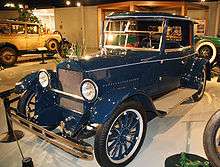Studebaker Light Six
The Studebaker Light Six was a car built by the Studebaker Corporation of South Bend, Indiana from 1918–1927.
.jpg)

Light Six
The Light Six originally came out in 1918.
| Year | Engine | HP | Transmission | Wheelbase | Tire Size |
|---|---|---|---|---|---|
| 1920–1921 | 207.1CID L-head 1-bbl. inline Six[1] | 40[2] | 3-speed manual | 112 in (2,845 mm) [1] | 32" |
Studebaker Standard Six
In August, 1924, the car was renamed the Studebaker Standard Six.
While in production, the Light Six / Standard Six represented Studebaker's least expensive model. The car was available in a full array of body styles throughout its production.
Studebaker Standard Six Dictator
In 1927, the car was renamed the Studebaker Standard Six Dictator in preparation for the 1928 model year when the car would be henceforth known as the Studebaker Dictator.
Standard Six Coach specifications (1926 data)
- Color - Belgian blue with black upper structure
- Seating Capacity – Five
- Wheelbase - 113 in (2,900 mm)
- Wheels - Wood
- Tires - 31” x 5.25” balloon
- Service Brakes - contracting on rear
- Emergency Brakes - contracting on drum at rear of transmission
- Engine - Six-cylinder, vertical, cast in block, 3-3/8 x 4-1/2 inches; head removable; valves in side; H.P. 27.3 N.A.C.C.
- Lubrication - Force-feed
- Crankshaft - Four bearing
- Radiator – Tubular
- Cooling – Water Pump
- Ignition – Storage Battery
- Starting System – Two Unit
- Voltage – Six to eight
- Wiring System – Single
- Gasoline System – Vacuum
- Clutch – Dry plate, single disc
- Transmission – Selective sliding
- Gear Changes – 3 forward, 1 reverse
- Drive – Spiral bevel
- Rear Springs – Semi-elliptic
- Rear Axle – Semi-floating
- Steering Gear – Worm-and-wheel
Standard equipment
The new car price included the following items:
- tools
- jack
- speedometer
- ammeter
- electric horn
- thief-proof lock
- automatic windshield cleaner
- demountable rims
- stop light
- spare tire carrier
- rear-view mirror
- sun visor
- cowl ventilator
- headlight dimmer
- clock
- dome light
Optional equipment
The following equipment on new cars was available at extra charge:
- Hydraulic four-wheel brakes with disc wheels
Source: Slauson, Harold Whiting; Greene, Howard (1926). "Leading American Motor Cars". Everyman’s Guide to Motor Efficiency. Leslie-Judge.
References
- Kimes, Beverly (1996). standard catalog of American Cars 1805-1942. Krause publications. ISBN 0-87341-428-4.
- "Directory Index: Studebaker/1920 Studebaker/album". Oldcarbrochures.com. Archived from the original on 2012-09-05. Retrieved 2012-06-01.
- Kimes, Beverly R.; Clark, Henry A. (1996). The Standard Catalog of American Cars 1805-1945. Krause Publications. ISBN 978-0-87341-428-9.